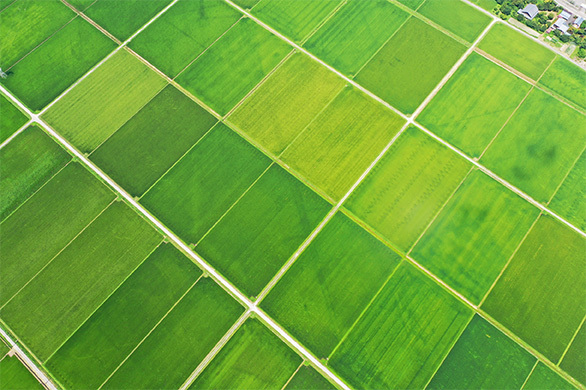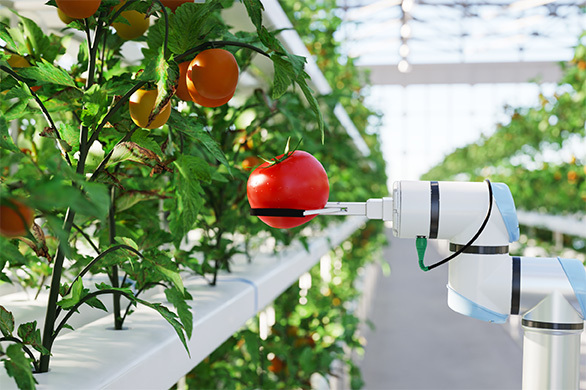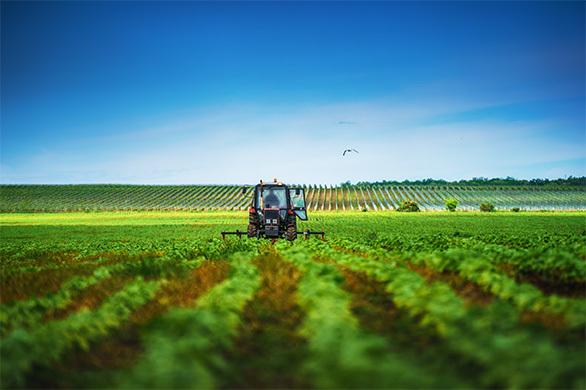
Multispectral Image Sensor
Technology
- Home
- Technology
- Image Sensor for Industrial Use
- Multispectral Image Sensor Technology
Overview
Sony’s multispectral image sensor technology forms a multispectral filter on the photodiode of each pixel, making it possible to capture multiple wavelengths of light simultaneously, from visible light to near-infrared light. Multispectral image sensors using this technology can be combined with specially designed signal processing software to capture image data of 41 wavelengths in just one shot, while still maintaining high resolution, making it possible to apply them in a wide range of scenarios.
Technical Features
Achieving both multispectral imaging and high resolution by combining filters and software
Sony’s multispectral image sensor technology features 8 filter patterns and it can capture 2D images from each filter in just one shot (Figure 1). The more patterns a sensor has, the more wavelengths it can capture but, as a drawback, this results in a lower spatial resolution due to the tradeoff relationship between capturable wavelengths and spatial resolution.
By combining Sony’s multispectral image sensors with proprietary, specially designed signal processing software, image data of 41 wavelengths (from 450 nm to 850 nm, in 10 nm intervals) obtained from 8 types of filters can be captured. Providing 41 filter patterns would reduce the spatial resolution but, by limiting it to 8 patterns and using signal processing software to increase the number of capturable wavelengths, Sony has achieved both multispectral imaging and high resolution.

Figure 1. Basic structure
Successfully downsized multispectral cameras by using an image sensor to split light
Most multispectral cameras are larger than normal cameras. This is because the image sensor itself cannot split light, so the cameras need a spectrometer, like a prism or diffraction grating, which can be large and expensive (Figure 2). However, Sony’s multispectral image sensors have multispectral filters built in, making it possible to split light with the image sensor alone. This allows for multispectral cameras that are the same size as normal cameras, which has opened the door to applications where size and weight limitations previously made their use prohibitive, such as agricultural drones.

Figure 2. Comparison of multispectral cameras
Applications
Observation of agricultural lands
The agricultural sector is currently seeing efforts toward data-based cultivation management, using cameras to photograph farmland from above to accurately judge how well crops are doing. However, it is not a simple task to make judgments on growth conditions using only the color data from captured images of crops. Multispectral image sensor photography creates spectral images of crops, allowing more efficient monitoring of growth and dispersion and making it easier to read the best times for watering and fertilization.
Related sectors

Harvesting crops
The ability to judge when to harvest is crucial in terms of crop quality. However, it can be hard to make this judgement based solely on color, shape, and appearance, so efforts are being made to use non-visible light to pick up changes in the reflective properties of crops as they mature. Multispectral image sensors can sense both visible and non-visible light simultaneously, so they can capture appearance information and maturity information simultaneously, making it easier to judge the optimal harvesting time.
Related sectors

Automatic driving for agricultural machinery
In order to address the problem of labor shortages, there is an increasing demand for autonomous agricultural machinery. In the case of cars, autonomous driving relies on white lines and road signs, but in the case of farmland, there are few reliable landmarks, so it is essential to collect a variety of information and be aware of the environment. Multispectral image sensors are suitable for capturing differences in the reflective characteristics of different materials, making it easier to effectively identify surrounding environments such as plants, soil, and puddles. This improves the accuracy of route selection in autonomous driving and contributes to the realization of automatic driving for agricultural machinery.
Related sectors

Download
IMX454 Product Ooverview
This document summarizes the product overview, features, and specifications.
Related Products & Solutions
-
Image Sensor
Multispectral Image Sensor
Find out more about multispectral image sensors using this technology
Product & Service Inquiries
Click here to request for a datasheet/quotation (RFQ)!
* This button will redirect you to the salesforce.com Co., Ltd. website,
which we have entrusted.
E-mail Newsletters
Find the latest information on our newsletter for industrial and security applications.